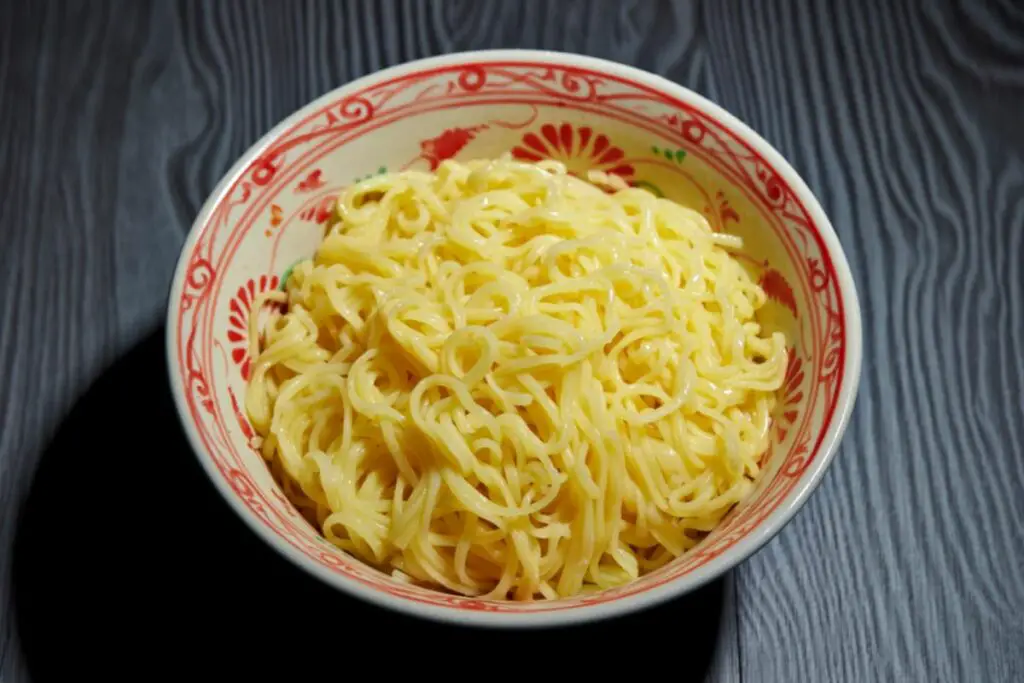Anyone who regularly eats instant ramen noodles has asked themselves at some point – what exactly is in these?
Sure, ramen noodles are super delicious but the ingredients list can be as long as your arm. And we all know that they are cooked before they go into the packet, but how are they cooked?

We have done the research! Keep reading to find out more about the cooking and manufacturing process of ramen noodles (see also ‘How To Eat Ramen‘).
Are Ramen Noodles Fried
All instant noodles are fried as part of their manufacturing process. Keep in mind that not all noodles used for ramen are instant noodles so may not be fried. All types of instant noodles are fried before they are put into the packet.
Both fried and non-fried noodles have the same basic recipe and ingredients. These are water, salt, and wheat flour. The major difference between the two is that instant noodles are then taken to the frier before being formed into a block and then put in a packet ready for retail.
Most instant noodle packets will list oil as an ingredient. This is because the noodles absorb a lot of fat as the water seeps out during the frying process.
How Are Instant Noodles Made
As all instant noodles are so similar, the manufacturing process is almost identical across brands. There may be some variations for noodle flavor, shape, size, or anything else but on the whole, they will follow this process.
First, the ingredients will be mixed to form a dough. This dough will then be flattened out into a few large sheets. Once the sheets of dough are at the correct thickness, fine strips will be cut. These ribbons are raw noodles.
The noodles will be divided into portions. This will be what is individually packaged and sold later on. The portions are steamed and then left to cool down. Now the noodles need to be dried out.
Due to the high quantities of water in raw noodles, frying them will turn the water into steam and allow it to escape. No water means that the noodles are dehydrated and ready to be packed as a block of just-add-water instant noodles.
The temperature of the oil that the noodles are fried in for this process is usually around 280° to 320° (140 °C to 160 °C). Using oil to dry them out takes the water content from somewhere between 30% and 40% to around 3%.
Removal of water will prevent them from going bad, hence their long shelf life.
Dehydrating noodles in this way has the added benefit of making them better soak up hot water when you go to prepare them. This decreases the cooking time, letting you eat them quicker, and warms them up more efficiently. All of this makes for a super tasty noodle.
Oil Content In Ramen Noodles

So, yes. Ramen noodles are fried if they are the instant noodle variety. But just how much oil do they contain?
The dehydrating process – when the noodles are fried – is very efficient at removing water, but that does mean that the water is replaced by oil. This can mean that your favorite pack of instant noodles can contain more than the USDA guidelines recommend for fat content.
The USDA recommends that a product should not have more than a fifth of its weight be fat or a fat derivative. As dehydrated noodles are light, it can be all too easy for them to surpass this 20% threshold.
Increasingly manufacturers are looking for alternatives in a bid to make instant noodles a little healthier. Some have started experimenting with different types of vegetable and plant oil.
Palm is becoming increasingly popular as it is a cheaper alternative that has slightly fewer calories and less saturated fat gram-for-gram.
Oil Alternatives
If the oil content is discouraged by the USDA, you may be wondering why instant noodle manufacturers don’t just stop using it altogether or find a wholly new substitute.
They have. It didn’t work. Some brands began air-drying their noodles after they were steamed instead of frying them. However, the water left the noodles too slowly altered the texture and increased the porosity too much.
This led to rubbery and bland, unappetizing noodles once the person who bought the pack added hot water.
Some manufacturers are modifying this practice with a little more success. Noodles that are essentially blow-dried in temperatures of around 175 °F (80 °C) have far fewer calories than their fried counterparts, but the texture is still too different to be a perfect replacement.
The beloved chewy and bouncy texture of noodles makes them satisfying to eat and is often what entices you back again and again.
How To Make Ramen Noodles Healthier
It is recommended that instant or ramen noodles be enjoyed as part of a healthy and balanced diet. That does not mean that you can’t enjoy your favorite ramen snack, it just means that you may need to experiment a bit with other ingredients to create a well-balanced meal.
Not only will this be delicious, but you may find that including more variety makes you feel better too.
Traditional ramen bowls are noodles served in a broth-like soup and come with some vegetables, some meat, and usually a boiled egg. Try different combinations of vegetables to find out what you like best, but why not start with the classics?
Some mushrooms, scallions, and carrots are all delicious and compliment the taste and texture of the ramen noodles well. Remember that color is good – the different colors in your vegetables generally represent the different vitamins and minerals you are getting.
Variety is important for a healthy diet!
Final Thoughts
Yes, ramen noodles are fried (see also ‘Can You Eat Ramen Raw?’). They are fried in the final stages of the manufacturing process to remove the water from the noodles. This increases the shelf life of the noodle packets and helps them absorb more water when you prepare them at home.
More water absorbed just before you eat them makes for a warmer and tastier noodle.
The oil content alone does not make instant ramen noodles unhealthy. Incorporating instant noodles as part of a varied and balanced diet can make for a nice treat every so often.
You can make noodles a little healthier by adding some veggies, meat, or egg to make the meal a little more balanced.









